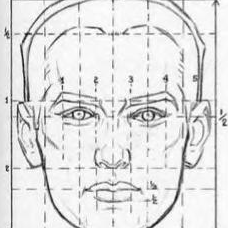


幕帖训练
醉汉带着许多节日礼物上了公共汽车。他死命地抓住车上的扶手,以防摔倒。售票员问:“要不要帮忙?”
醉汉回答:“请吧,你帮我抓住扶杆,我来掏钱买票。”
- Read more...
- 3 comments
- 4162 views

To improve my handwriting skill I am working through the exercises prescribed in《席殊3SFM实用硬笔字60小时训练》. As I do so I will share vocabulary lists and my answers for each of the sections. This book does not appear to have an answer key for any of its practice problems. You will need to purchase your own copy of the book to learn the material in this course. If you disagree with any of my answers please let me know in the comments. Find an index here.



幕帖训练
醉汉带着许多节日礼物上了公共汽车。他死命地抓住车上的扶手,以防摔倒。售票员问:“要不要帮忙?”
醉汉回答:“请吧,你帮我抓住扶杆,我来掏钱买票。”

By 大块头,
Page 40 has a table of calligraphy models for 221 high frequency characters. As is typical for this book, there is no annotation explaining what each character is supposed to be. After posting a dozen questions on HelloTalk, I think I've figured them out.
Can you read all of them?
| A | B | C | D | E | F | G | H | I | J | K | L | M | |
| 1 | 的 | 一 | 是 | 在 | 不 | 了 | 有 | 和 | 人 | 这 | 中 | 大 | 为 |
| 2 | 上 | 个 | 国 | 我 | 以 | 要 | 他 | 时 | 来 | 用 | 们 | 生 | 到 |
| 3 | 作 | 地 | 于 | 出 | 就 | 分 | 对 | 成 | 会 | 可 | 主 | 发 | 年 |
| 4 | 动 | 同 | 工 | 也 | 能 | 下 | 过 | 子 | 说 | 产 | 种 | 面 | 而 |
| 5 | 方 | 后 | 多 | 定 | 行 | 学 | 法 | 所 | 民 | 得 | 经 | 十 | 三 |
| 6 | 之 | 进 | 着 | 等 | 部 | 度 | 家 | 电 | 力 | 里 | 如 | 水 | 化 |
| 7 | 高 | 自 | 二 | 理 | 起 | 小 | 物 | 现 | 实 | 加 | 量 | 都 | 两 |
| 8 | 体 | 制 | 机 | 当 | 使 | 点 | 从 | 业 | 本 | 去 | 把 | 性 | 好 |
| 9 | 应 | 开 | 它 | 合 | 还 | 因 | 由 | 其 | 些 | 然 | 前 | 外 | 天 |
| 10 | 政 | 四 | 日 | 那 | 社 | 义 | 事 | 平 | 形 | 相 | 全 | 表 | 间 |
| 11 | 样 | 与 | 关 | 各 | 重 | 新 | 钱 | 内 | 数 | 正 | 心 | 反 | 你 |
| 12 | 明 | 看 | 原 | 又 | 么 | 利 | 比 | 或 | 但 | 质 | 气 | 第 | 向 |
| 13 | 道 | 命 | 此 | 变 | 条 | 只 | 波 | 结 | 解 | 问 | 意 | 建 | 月 |
| 14 | 公 | 无 | 系 | 军 | 很 | 情 | 者 | 最 | 立 | 代 | 想 | 己 | 通 |
| 15 | 并 | 提 | 直 | 题 | 光 | 程 | 展 | 王 | 果 | 料 | 象 | 员 | 革 |
| 16 | 位 | 入 | 常 | 文 | 总 | 次 | 品 | 式 | 话 | 设 | 及 | 管 | 特 |
| 17 | 件 | 长 | 求 | 老 | 头 | 基 | 资 | 边 | 流 | 路 | 级 | 少 | 图 |

By 大块头,

举一反三
相,答,笙,笔,机,校,权,自,看,省,着,眼,眉
摹帖训练
哥尔登在整个拳击比赛中,一直眉开眼笑。
他身旁的人问他:“你也是拳击师吗?”
哥尔登回说:“不,我是牙科医生!”
作业

By 大块头,

举一反三
礼,社,视,初,神,被,祖,田,富,副,逼,亩
摹帖训练
物理老师:“电与闪电有什么区别?”
学生:“闪电不用付钱。”
作业

By 大块头,
(Characters in red are those I'm still not sure about, even after asking on HelloTalk.)

举一反三
诚,城,感,盛,咸,减,喊,或,划,戏,截,威,载
摹帖训练
有一位顾客买了一件皮袄。
“这件皮袄我很喜欢,但是它怕水吗?”
“当然不怕啦,”售货员说,“难道你见过打雨伞的兔子吗?”

By 大块头,

举一反三
(missing from this section both in this and the previous edition of this textbook)
摹帖训练
老师:“菲利,你们班上有一句口头禅,你知道是什么吗?”
菲利:“不知道。”
老师:“说得对。
作业

By 大块头,

举一反三
石,布,月,青,首,背,骨,朋,脑,能,脱,脂,胖
摹帖训练
数学教师:“……现在,我们可以得出结论,x等于零。”
学生:“唉!算了这老半天,都白费功夫了!”
作业

By 大块头,

举一反三
王,玉,主,全,玩,责,往,注,现,性,姓,胜,牲
摹帖训练
“爸爸,什么叫‘资本’,什么叫‘劳动’?”
“是这样的:如果我从邻居家借了一百卢布,我就有了‘资本’,如果他想从我这儿讨回这笔钱,他就必须‘劳动’。”
作业

By 大块头,

举一反三
元,克,兄,光,先,也,电,风,充,现,视,欢,规
摹帖训练
一位肥胖的妇女对前来车站迎接她的朋友说,“售票员真糊涂,刚才还说车子挤满了,可我一下车,他就说车上还可以乘三位。”
作业

By 大块头,

vocabulary
举一反三
大,天,太,犬,合,会,命,队,众,过,建,文
摹帖:伪币
跑堂的:“你给我的小费是一枚伪币。”
顾客:“是你找钱时给我的呀!”
跑堂的:“你明明知道我不想要它。干嘛偏要给我呢?”
作业

By 大块头,
(no vocabulary)

By 大块头,
vocabulary

By 大块头,
(to be updated with more entries as I work through the book)